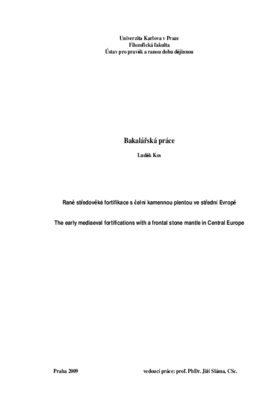Raně středověké fortifikace s čelní kamennou plentou ve střední Evropě
The early mediaeval fortifications with a frontal stone mantle in Central Europe
bachelor thesis (DEFENDED)

View/
Permanent link
http://hdl.handle.net/20.500.11956/27211Identifiers
Study Information System: 76603
Collections
- Kvalifikační práce [23975]
Author
Advisor
Referee
Štefan, Ivo
Faculty / Institute
Faculty of Arts
Discipline
Prehistoric and Early Medieval Archeology
Department
Institute of Archaeology
Date of defense
14. 9. 2009
Publisher
Univerzita Karlova, Filozofická fakultaLanguage
Czech
Grade
Excellent
Předložená práce se zabývá fortifikací s čelní kamennou plentou v prostoru střední Evropy. Shrnuje dosavadní stav bádání z hlediska rozšíření jevu, konstrukční poznatky a pohledy na jeho chronologické a kulturní aspekty. Práce se rovněž věnuje některým metodickým problémům výzkumu opevnění. Studovaný typ našel v raném středověku široké uplatnění jak na územích franských, tak na územích slovanských, konstrukční rozdíly v opevněních s kamennou zdí nasucho kladenou jsou jeho variantami zohledňujícími i místní tradice. Z důvodů chronologických, historicky doloženého kontaktu i vlivů na ostatní druhy architektury a život slovanské elity, je třeba pokládat franský původ tohoto typu fortifikace za pravděpodobný.
The presented work deals with the fortification with a frontal stone mantle in the area of Central Europe. It summarizes the current state of research with regard to the extension of the phenomenon, construction knowledge and chronological and cultural aspects. It also treats of some methodological problems in study of fortifications. The type in question was widely used in the Early Middle Ages in the Frankish area as well as in the Slavic one, the construction differences of the fortifications with a dry laid stone wall represent various manners of their usage reflecting territorial traditions. The Frankish origin of this fortification type is probable based on chronological reasons, historically attested contacts and influences on other parts of Slavic architecture and the lifestyle of the elite.
